The Bilunabirotunda
The bilunabirotunda is the 91st Johnson solid (J91). Its surface consists of 14 faces (8 equilateral triangles, 4 regular pentagons, 2 squares), 26 edges, and 14 vertices.
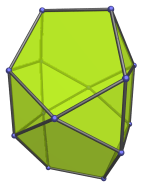
The bilunabirotunda is one of the special Johnson solids at the end of Norman Johnson's list that are not directly derived from the uniform polyhedra by cut-and-paste operations. Nevertheless, it is related to the icosidodecahedron: the “rotunda” part of its name refers to the configuration of two pentagons and two triangles around a vertex, which is actually part of the surface of the pentagonal rotunda (J6), which in turn is just half of an icosidodecahedron. The “luna” part of its name is defined by Norman Johnson as the triangle-square-triangle strip found on either side of the rotunda patches. There are two such patches of the pentagonal rotunda's surface and two such luna, hence the name, bi-luna-bi-rotunda.
The bilunabirotunda is also related to the icosahedron via a modified partial Stott expansion that pulls apart four of its pentagonal cross-sections to form the pentagonal faces of the bilunabirotunda. This derivation is depicted below:
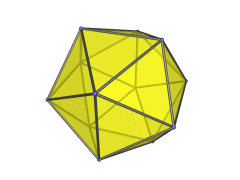
Projections
In order to be able to identify the bilunabirotunda in various projections of 4D objects, it is useful to know how it appears from various viewpoints. The following are some of the viewpoints that are commonly encountered:
| Projection | Envelope | Description |
|---|---|---|
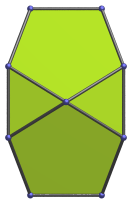 |
Octagon | Parallel projection centered on an icosidodecahedral vertex. |
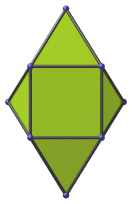 |
Rhombus | Parallel projection centered on a square face. The four pentagons project to the edges of the rhombus. |
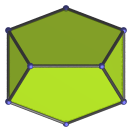 |
Hexagon | Parallel projection centered on top and bottom edges. |
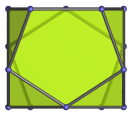 |
Rectangle | Parallel projection parallel to a pair of opposite pentagons. |
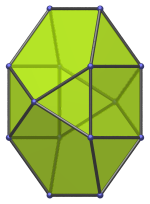 |
Octagon | Parallel projection showing a 45° side-view. It may not be immediately obvious, but this projection has bilateral symmetry both vertically and horizontally. |
Coordinates
The Cartesian coordinates of the bilunabirotunda are:
- (±1, 0, ±φ2)
- (±φ, ±1, ±1)
- (0, ±φ, 0)
where φ=(1+√5)/2 is the Golden Ratio.
Occurrences
Despite its unusual shape, the bilunabirotunda has been found to occur in many CRF polychora related to the 120-cell family of uniform polytopes, due to its deep connection with the icosahedron. Among these are:




